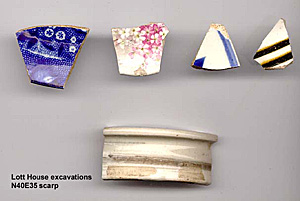

| |
| Lott House Q&A |
"Brooklyn's Eighteenth-century Lott House" 1999-2001 |
 |
 |
| The ceramics from N40E35 scarp From left to right, top row: The rim of a flow blue transfer-print plate c. 1835 was found in the same scarp as the polychrome earthenware from the early twentieth century; the painted pearlware plate dating to 1820-1825; and the American banded slipware fragment (slipwares are largely eighteenth-century ceramics but were made throughout the first quarter of the nineteenth century). The potsherd in the bottom row is also from that scarp, representing half the top of a pearlware ginger jar. Though most ginger jars were painted blue, this one is painted brown and was probably made in England. |
The ceramics from N36E35 Unit 3 From left to right, top row: A flow blue pearlware transfer-print plate rim; a potsherd of blue transfer print in a floral design; and a potsherd of blue non-floral transfer print 2nd row: A fragment of blue painted pearlware (ca. 1820); blue transfer-print pearlware; a fragment of flow blue transfer print; and a fragment of blue painted pearlware. Bottom row: A piece of red glazed wheel-turned stoneware and a piece of glazed redware |
| As a rule of thumb, at this site earthenwares (pearlwares [1805-1845], creamwares, and white wares) were made in England. Unless otherwise noted, assume utilitarian slipwares and redwares (eighteenth and early nineteenth century), as well as stonewares were made in America. (Photos courtesy Brooklyn College) |
© 1999 by the Archaeological Institute of America archive.archaeology.org/online/features/lott/qs/q5a.html |
Advertisement

Advertisement






